
Daily report by GM Alexander Baburin from Turkey
Day Eleven, 7th November 2000. For
the some the US presidential election may be the highlight of the day, for many
people down in Istanbul it was the 10th round of the Olympiad! :-)
Our team did really well, beating Cyprus Qatar 31/2-1/2. Playing White on board
one, I offered a draw to GM Kotronias after 8 moves, as I felt pretty sick.
Fortunately he did not mind a quick draw and so I retired to my hotel room...
Unfortunately, our ladies team lost to Mexico.
By the way, I would like to mentioned that the
Irish teams received some sponsorship from an Internet company www.all-hotels.com
This support is modest yet, but hopefully it will grow - the Irish chess badly
needs something like this!
On the top tables Russia smashed Rumania 4-0 and
jumped into the first place.
Russia. Other results from the top:
Ukraine-Bulgaria 21/2-11/2, Hungary-USA 2-2 and Israel-Denmark 2-2.
After 10 rounds the standing is a follows: 1.
Russia - 28 points
2. Germany - 271/2 points 3. Ukraine - 27 points
4. Armenia - 261/2 points 5-6. Hungary and Bulgaria - 251/2 points 7-9. Israel,
USA and Bosnia - 241/2 points.
In women's Olympiad the 10th round
did not change much in the leading group: China beat Ukraine 2-1, while Georgia
defeated Romania with the same score. Now it is a race between China and
Georgia. With 4 rounds to go the standing is:
1. China - 23 points, 2. Georgia - 221/2 points,
3-4 Russia and Netherlands - 20 points.
So far I am playing reasonably well here, as
even in the game I lost I actually played OK and only one serious error ruined
my winning chances. Here I would to show this curious game:
M. Al-Modiahki (2502) - A. Baburin (2590) (View
Game and notes in Game Viewer.)
1 e4 Nf6 2 e5 Nd5 3 d4 d6 4 c4
Nb6 5 exd6 exd6 6 Be3 Be7 7 Bd3
I think that such 'simple'
development does not give White any advantage.
7...Nc6 8 Nf3 Nb4! 9 Be2 Bf5 10
Na3
Now White's knight is pretty
awkwardly placed on a3. 10...d5!

I felt that it was important to
take away from White the possibility of d4-d5. Besides, Black does not have any
other plan than to go ...d5 at some point.
11 c5 Nd7 12 0ö0 0ö0 13 Qb3
a5 14 Rac1
White wants to play Nb1 and
a2-a3, therefore Black must hurry up:
14...b6! 15 Nb5
This is an interesting idea. I
expected 15 cxb6, when I was going to play 15...Nxb6; 15...c6 is also possible.
15...c6
After 15...bxc5 16 dxc5 c6 White
would, of course, play 17 Nbd4.
16 Nd6 Bxd6
I also considered 16...Bg4 here,
but then decided that it would be better to get rid of the d6-knight.
17 cxd6 c5!
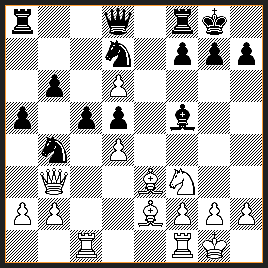
This move and the following line
is the only way to justify 16...Bxd6.
18 dxc5 bxc5 19 Bxc5 Bc2!
The line 19...Nxc5 20 Rxc5 Qxd6
21 Rfc1 is not what I played 16...Bxd6 for!
20 Qc3
This is yet another interesting
solution, although this sacrifice is not forced. The variation 20 Rxc2 Nxc2 21
Qxc2 Rc8 is better for Black, but the line 21 Qxd5! Rc8 22 Bd4 Nxd4 23 Qxd4 is
OK for White. Probably it is objectively stronger than what he played in the
game.
20...Rc8!
I guess White would be happy
after 20...Nxa2 21 Qxc2 Nxc1 22 Rxc1 Rc8 23 Qf5.
21 Bxb4 Rxc3 22 Bxc3 Be4 23 Bd4!
Nf6!?
23...Re8!? was interesting too,
but I had a particular manoeuvre in mind:
24 Rc6 Nh5
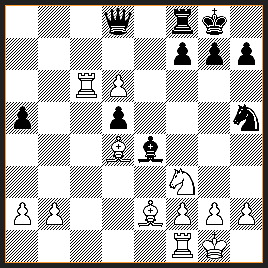
Black is trying to employ his
knight. White must not allow the knight to f4, but this leads to weakening of
his king.
25 g3! Qd7 26 Ne5 Here
White offered a draw, but Black can and should play for a win. 26...Qh3
27 f3 Nxg3 28 hxg3 Qxg3+ 29 Kh1 Qh3+ 30 Kg1 Qg3+ 31 Kh1 Bf5!
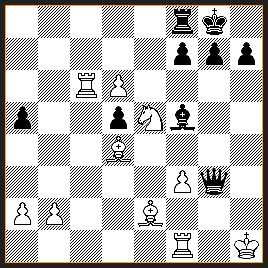
32 Ng4
Perhaps, better was 32 f4, but
such a move is easier to suggest than to make! Black is still better after
32...Be4+ 33 Bf3! f6 34 Bxe4 dxe4 35 Rc7 e3 36 Rxg7+ Qxg7 37 Rg1 Qxg1+ 38 Kxg1
fxe5 39 Bxe5.
32...Qh4+ 33 Kg2 h5??
I saw 33...Re8!, but decided
that 33...h5 was winning by force. I guess that subconsciously I was afraid that
somewhere White would have d6-d7 with a tempo. 33...Re8! would have given Black
a big, if not winning, advantage after 34 Bd1 h5 35 Bf2 Qg5 36 f4 Qxf4 37 Nh2.
Now White comes up with a great shot:
34 Bf6!!
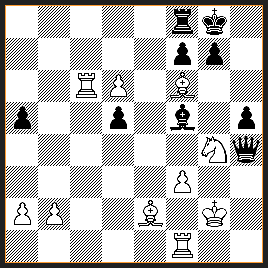
I saw the line 34 Rh1? Qg5 35
Bf6 Qg6!. When I considered 31...Bf5!, I saw the idea of 34 Bf6!! too, but that
was just a passing thought, which unfortunately did not quite register in my
mind. Otherwise I would have played 33...Re8 without any thinking.
34...gxf6 35 Rh1 Qg5??
Black had to play 35...Qxh1+ 36
Kxh1 hxg4 37 fxg4 Be4+ 38 Kg1 Rd8, although the ending is very unpleasant.
36 Rxh5 Qd2 37 Nh6+ Kg7 38 Nxf5+
Kg6 39 Ng3
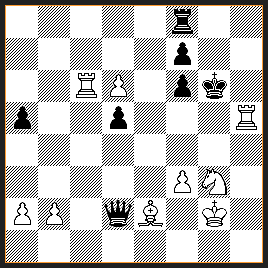
This knight is a fantastic
worker! Now Black is lost.
39...Re8 40 Kf1 d4
After 40...Rxe2 41 Nxe2 Kxh5 42
d7 the d-pawn is unstoppable.
41 d7 Rxe2 42 Rxf6+ Kg7 43 Nf5+
Kxf6 44 d8Q+ Kg6 45 Qg8+ Kf6 46 Qg7+ 1ö0
Come back tomorrow for my next
report!
|


